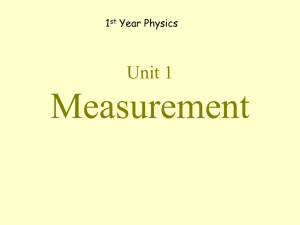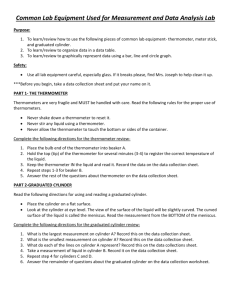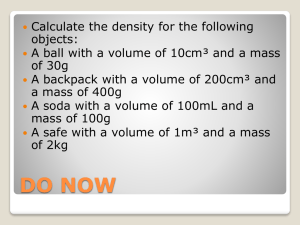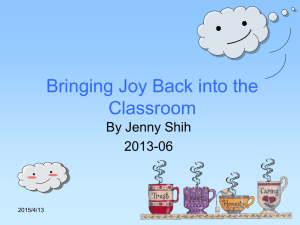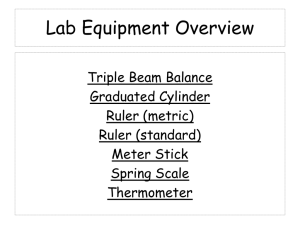SCIENCE
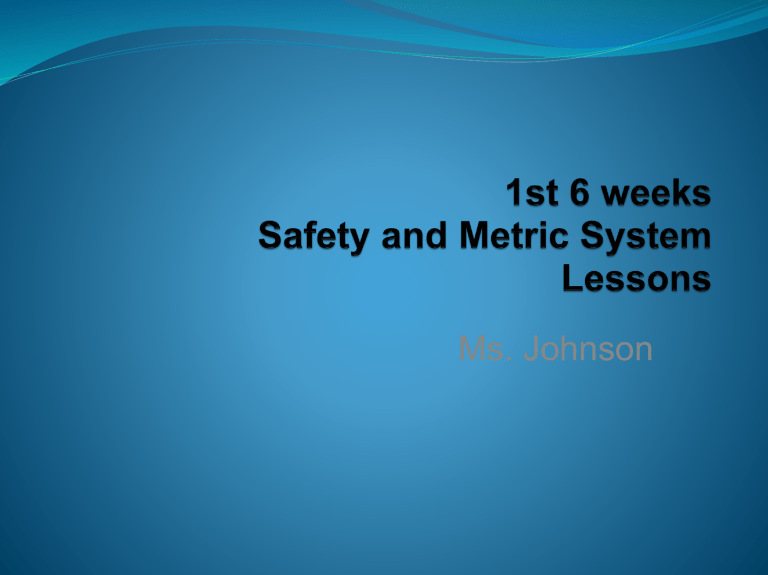
Ms. Johnson
Today:
BELL WORK
Get out your planner.
Find your passport.
Finish decorating the front cover.
Finish/ start your goals page.
Finish/ start your T-chart. (likes vs. dislikes)
VIDEO CLIP
http://www.youtube.com/watch?v=47rQkTPWW2I
HOW DOES THIS RELATE TO WHAT WE TALKED
ABOUT YESTERDAY?
•
•
•
A way of learning more about the natural world that provides possible explanations to questions and involves using a collection of skills.
Science helps us answer questions and solve problems.
Science is the process of trying to understand the world.
Observation
Background Information: One of the most important skills in science is that of OBSERVATION.
Most of the time we think of observation as something we do with our eyes; when we see something, we observe it.
However, all five of our senses can be used to make observations: sight, hearing, taste, touch, and smell.
We can make two kinds of observation: those that are
FACTS, and those that are OPINIONS. Facts are those things that are true for everybody. Opinions are beliefs based on personal preference.
Observation Activity
Procedure:
1. Close your eyes.
Keep them closed!
2. Use your sense of TOUCH to observe the object I put in you hand.
3. Write at least three sentences describing what you observed.
4. Use your sense of HEARING as you LISTEN the object.
5. Write at least three sentences describing what you observed.
6. Use your sense of SIGHT to observe the object.
7. Write at least three sentences describing what you observed.
8. Use your sense of SMELL to observe the object.
9. Write at least three sentences describing what you observed.
10. Place the object in your mouth.
Use your sense of TASTE to observe it.
11. Write at least three sentences describing what you observed.
• Describe the purpose and care of commonly used pieces of lab safety equipment such as: triple beam balance, graduated cylinder, thermometer, spring scale, and ruler.
GUIDING QUESTIONS
• Explain the purpose of at least five lab safety rules.
GUIDING QUESTIONS
•
•
What measuring tools would you use to determine the following physical properties of matter: length, temperature, mass, volume, weight and density?
What tools are used to determine the boiling point of a substance?
GUIDING QUESTIONS
• Demonstrate the ability to find the volume of a regular and irregular solid.
OBJECTIVES -
1. The locations and usage guidelines of safety equipment in the classroom
2. There are lab safety rules that must be followed in the lab
3. Understand purpose of MSDS -
M
aterial
S
afety
D
ata
S
heets.
•
•
•
•
•
Bell Work
GET OUT YOUR SIGNED SAFETY CONTRACT AND CLASS
RULES.
Grab your passport.
What would you do if one of your classmates was injured in class?
Work with your groups and develop a set of 3 guidelines for working in a science lab.
Write your 3 guidelines in your passport.
Video Clip
Safety Warm Up 1:
United Streaming Video Segment:
Safe Science: 3:40
Sixth Grade Science Laboratory Safety Rules
• I’m Labbie, your laboratory retriever.
When you see me, it’s a friendly reminder to follow all lab rules and safety procedures.
Sixth Grade Science Laboratory
Safety Rules
Scientific laboratory is a place of adventure and discovery. Some of the most important events in scientific history have happened in laboratories. The antibiotic powers of penicillin were discovered in a laboratory. Plastics used today for clothing and other products were first made in a laboratory. The list is endless.
•
Sixth Grade Science Laboratory
Safety Rules
One of the first things any scientist learns is that working in the laboratory can be an exciting experience. However, the laboratory can also be quite dangerous if proper safety rules are not followed at all times. In order to prepare yourself for a safe year in the laboratory, read the following safety rules. Then read them a second time. If you do not understand each rule, ask your teacher to explain any rule that is unclear.
SAFETY CONTRACT
ENGLISH
http://www.flinnsci.com/Documents/miscPDFs/safet y_contract_MS.pdf
SPANISH
http://www.flinnsci.com/Documents/miscPDFs/safet y_contract_MS_SP.pdf
Safety Contract
•
•
•
•
•
•
•
•
•
•
•
Dress Code
Tie back long hair.
Remove dangling jewelry.
Do not wear loose, billowy clothing.
Wear closedtoed shoes; sandals don’t protect your feet.
Laboratory Behavior
Read all directions for an experiment several times. Listen carefully during the prelab. Ask questions if you do not understand any part of the experiment. Follow the directions exactly as they are written.
Make sure the work area has been cleared of purses, books, jackets, etc.
Before starting the lab, be aware of all safety precautions and know the location of all safety equipment.
Do not speak loudly or engage in horseplay in the laboratory.
Never eat or drink in the laboratory.
•
•
•
•
•
•
•
•
•
Safety Contract
•
•
•
• Safety During the Laboratory Lesson
Never perform activities that are not authorized by your teacher .
Do not handle any equipment unless you have permission.
Wear safety goggles, lab aprons, and protective gloves when required. Take extreme care not to spill or break any material in the laboratory.
Clean-up procedure
Follow your teacher’s instructions for proper disposal of chemicals; do not pour anything down the drain unless instructed to do so.
Do not work alone in the lab.
Report all accidents to your teacher immediately .
End-of-Experiment Rules
Clean up your work area and return all equipment to its proper place.
Wash your hands after every experiment.
Safety Contract
• You will now receive your personal safety contract. This MUST be signed and returned by tomorrow.
• You MUST read over the rules and sign with your parent.
• IF YOU DON NOT HAVE YOUR SIGNED SAFETY CONTRACT, YOU WILL
NOT BE ABLE TO PARTICIPATE IN LABS. NO EXCUSES.
• If you lose your contract you may print another one from the notes on the website.
Safety Spots in Our Class
• Eyewash fountain demonstration.
• Show location of fire blanket, fire extinguisher.
• Aprons and gloves.
• Goggle cleaning station.
Map of Classroom
Draw a map of the classroom.
Label all of the safety spots.
(Fire blanket, goggle station, fire extinguisher, eyewash station)
Label all the exits.
RECYCLING AND CONSERVATION
• What substances can be washed down the drain?
• Never return unused chemical to an original jar (called a
“stock jar” or the “reagent jar”).
• Review types of items that can be recycled: glass, paper, aluminum, certain plastics, etc. (NOT WOOD)
•
MSDS
M aterial S afety D ata S heets.
•
General hazard warning
o When you see this symbol, triple check for safety issues
•
•
•
Wear goggles when using: o o o
Chemicals
Sharp objects
Fire
NON-NEGOTIABLE
It’s a LAW!
• Fire hazard o o
Use goggles
Tie back long hair o Tie back loose clothing
• Electrical Hazard o Watch for water o Be aware of cords
• Poison Hazard o o
Wear goggles
Read label o Keep away from mouth
• Corrosive Hazard o o o
Wear goggles
Read labels
Wear apron o Keep off skin
Activity- Safety Symbols
http://www.sciencef class.net/Graphic_Organizers/GO_wheel_safety.pd
What is WAFT?
TEST FOR ODORS
Odors from chemicals may be dangerous. To test an odor:
1. Hold the test tube
2. Keep the test tube several inches away from your nose
3. Waft (fan with your hand) the fumes coming from the test tube toward your nose.
• http://www.edquest.ca/component/content/ article/110
• http://school.discoveryeducation.com/quizz es28/mpoarch/SafetyQuiz.html
Dear Mad Scientist Safety Letter:
You are the Mad Scientist. Yesterday you received this note in the mail. Now you need to reply providing the science student with the information they requested.
Dear Mad Scientist,
School starts in a few days. I am excited and nervous. I love science and can’t wait to get into science lab! Last year I got in trouble a lot for playing with the materials and making my own directions. What should I do so I don’t get in trouble this year?
Sincerely,
Curious Kate
Dear Curious Kate,
Sincerely,
Mad Scientist
•
• OBJECTIVES
Various pieces of equipment are used in the lab
• There is a proper way to use and care for all pieces of lab equipment
Your Journals
Yes, journals are a type of lab equipment.
You are going to be keeping a science all year.
This journal will be a place for NOTES and
VOCABULARY, as well as some LABS and
ACTIVITIES.
You will have quizzes over the information in your journal.
You must bring your journal to class EVERYDAY.
• Measuring mass
Triple Beam Balance
Expert Information: Balances are used to measure mass.
The units of mass are grams (g) and kilograms (kg).
The instrument you will use most often to measure mass is the triple beam balance. The triple beam balance gets its name from three long, horizontal metal bars called beams connected to a pointer on the right-hand side. The pointer should always be at
zero point before obtaining the mass of any object.
On each beam is a rider that slides across the beam.
Before using a triple beam balance, you should remember the following:
Slide all riders back to “0” on the beams before massing any object. Use the adjustment knob to zero out the instrument if necessary.
Place the object to be massed on the pan. Chemicals should be placed on waxed or filter paper before massing.
Gently slide the riders along the beams while determining mass. The pointer will swing above and below the zero point while you are adjusting the riders.
Make sure each rider is in a notch before reading.
The mass of the object will be the sum of the masses on all beams.
Always return the riders to zero BEFORE removing the object from the pan.
• http://www.wisconline.com/objects/ViewObject.aspx?ID=G
CH202
Graduated Cylinder
Expert Information: A graduated cylinder is used to measure liquid volume.
The unit is the milliliter, abbreviated mL. To use a graduated cylinder, you must remember the following:
Place the graduated cylinder on a flat surface and view the height of the liquid in the cylinder with your eyes directly level with the liquid. The liquid will tend to curve downward. This curve is called the meniscus.
The graduated cylinder will usually have heavy markings at 10, 20, 30 . . .
milliliters. There are usually smaller markings in between the larger units called
graduations. Read the graduated cylinder to the nearest tenth of a milliliter (31.5
mL or 30.0 mL).
Meniscus
Notice how the liquid curves up the side of the graduated cylinder.
To get the most accurate reading, read the measurement at the bottom of the curve, or meniscus.
• Using_a_Thermometer.doc
• Measures temperature Celsius
Thermometer
Expert Information: A thermometer is a tool or instrument used to measure
temperature.
Thermometers should be handled with care. They are tubes of glass filled with either mercury or colored alcohol. At the bottom of the tube is a wider part called the bulb. When the bulb is heated, the liquid in the bulb expands or gets larger, causing the liquid to rise in the tube. When the bulb is cooled, the liquid contracts or gets smaller, causing the liquid to fall in the tube. The bulb at the base of the thermometer should be immersed in the material to be measured. To use a thermometer, you must remember the following:
The thermometer does not need to be shaken down.
If you are measuring the temperature of a material that is being heated, make sure the thermometer bulb is not resting on the bottom of the container.
To read the temperature, your eyes should be level with the liquid in the thermometer.
Read the temperature at the closest line to the liquid.
Thermometer
42ºC Small divisions are each two degrees
After determining the number of degrees, establish the value of the lines between the numbers.
Read the temperature to the nearest degree using the lines between the numbers.
Thermometers are graduated differently so you must determine what value each smaller
11ºC Small divisions are each one degree.
division represents. In science, we will use only the Celsius scale (ºC) . The unit must follow all numbers. EX: 34
C
•
•
•
•
•
Degrees Celsius ° C
0oC - freezing point of water
100oC - boiling point of water
23 oC - room temperature
37 oC - human body temperature
• Using_the_Metric_Ruler.doc
Metric Ruler
Expert Information: The standard unit for measurement of length in the metric system is the meter .
In science lab, most measurements are much smaller than a meter.
A metric ruler is the standard instrument for measurement in the scientific laboratory.
On a metric ruler, each individual line represents a millimeter ( mm ). The numbers on the ruler represent millimeters ( mm ). There are 10 millimeters for each centimeter.
Metric Ruler
To read a metric ruler, each individual line represents .10 (1/10) of a centimeter,
or 1 millimeter. Notice when converting from centimeters to millimeters,
the decimal point is moved one place to the right.
To convert millimeters,
to centimeters, move the decimal point one place to the left.
•
•
•
•
Meters (m)
Millimeters (mm)
Centimeters (cm)
Kilometers (km)
Beaker
Holding liquid and dry chemicals
Mixing chemicals
Measuring large amounts of chemicals
• Used for force
Equipment
Stopwatch
SECONDS, MINUTES
Beaker- mL
Picture
Graduated Cylinder mL
Meter Stick or Ruler mm, cm
Spring Scale
N
Thermometer- Celsius
Triple Beam Balance grams use
Timing short periods of time
Holding liquid and dry chemicals
Mixing chemicals
Measuring large amounts of chemicals
Measuring small amounts or chemicals
Measuring length and distance
Measuring force
Measuring heat
Measuring mass
